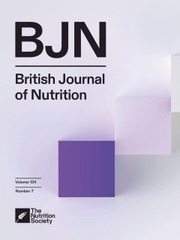Article contents
Antioxidant vitamin intakes assessed using a food-frequency questionnaire: correlation with biochemical status in smokers and non-smokers
Published online by Cambridge University Press: 09 March 2007
Abstract
The increasing interest in the possible role of antioxidant vitamins in many disease states means that methods of assessing vitamin intakes which are suitable for large-scale investigations are now required. The suitability of the food-frequency questionnaire, which was developed by the Medical Research Council – Cardiff Group, for determining dietary intake of antioxidant vitamins in epidemiological studies was investigated in 196 Scottish men. The validity of the dietary data was assessed by comparison with serum vitamin concentrations, and separate analyses were performed for current smokers and non-smokers. The results showed that total energy intake and the percentage of energy derived from sugar were higher in smokers, and that both dietary and serum values of vitamin C, β-carotene and vitamin E were lower in smokers than non-smokers. After adjustment for serum lipids, energy intake and body mass index, correlation coefficients between dietary and serum vitamins C and E were similar for smokers (r 0.555 and 0.25 respectively) and non-smokers (r 0.58 and 0.32 respectively). Correlation between dietary and serum carotenes was reduced from 0.28 in non-smokers to 0.09 in smokers and correlations for retinol and total vitamin A were weakly significant only for non-smokers. The food-frequency questionnaire assigned > 70% of subjects correctly into the upper or lower plus adjacent tertiles of serum vitamin values, with the exception of β-carotene and total vitamin A for smokers. Thus, the food-frequency questionnaire appeared to be an adequate tool for assigning individuals into tertiles of serum antioxidant vitamins with the main exception of β-carotene for smokers. Marked differences do occur between the vitamins and between the smoking groups which may reflect reduced accuracy of reporting on the food-frequency questionnaire or differential absorption and metabolism of the vitamins.
Information
- Type
- Nutrient Intake and Status
- Information
- Copyright
- Copyright © The Nutrition Society 1991
References
REFERENCES
- 135
- Cited by

